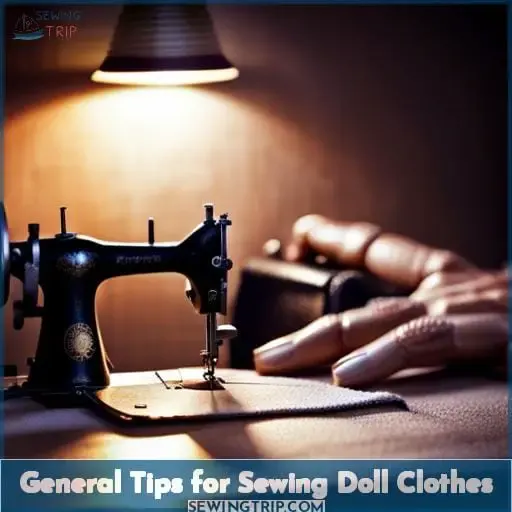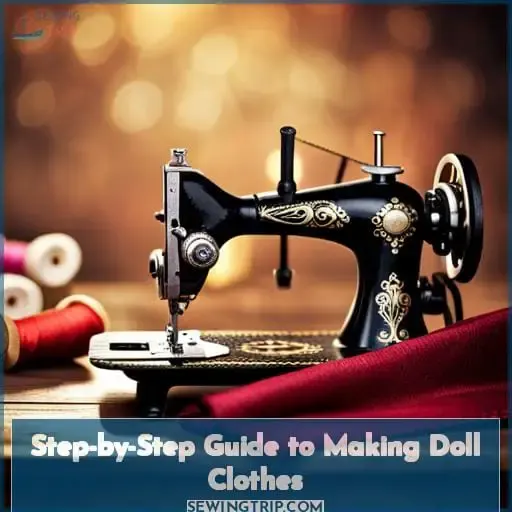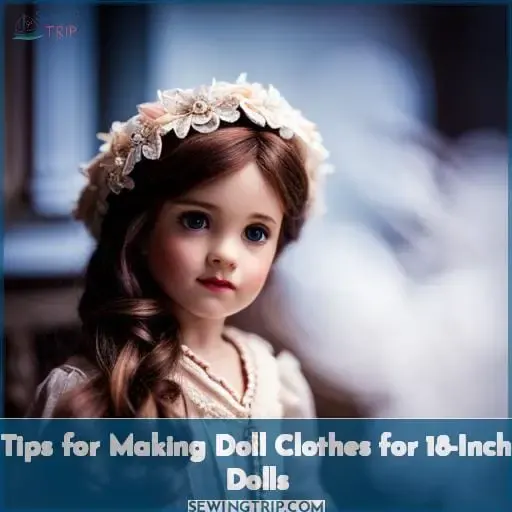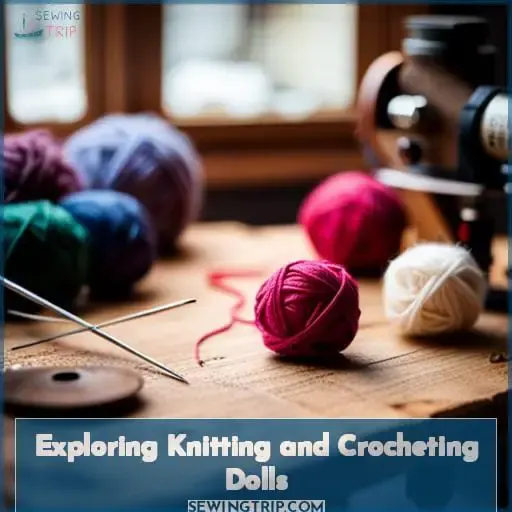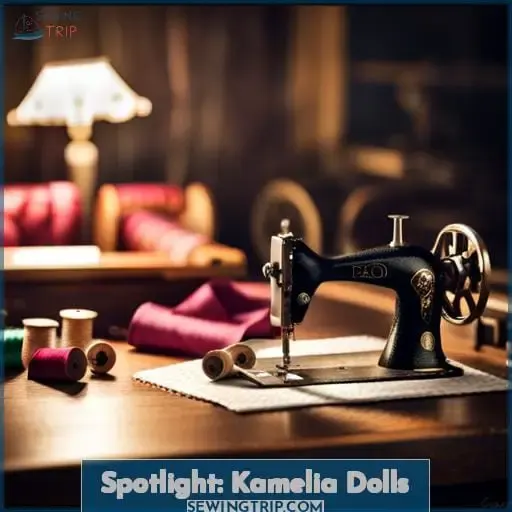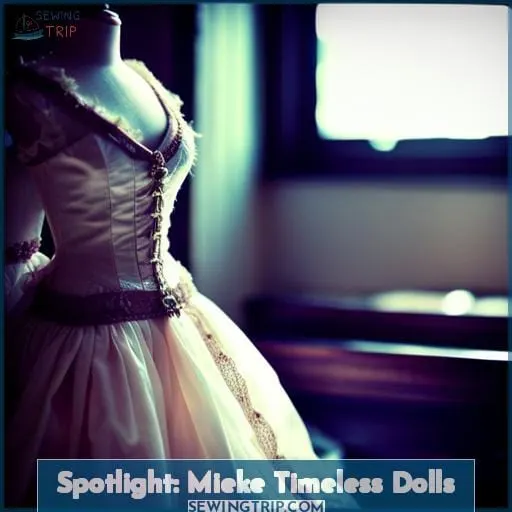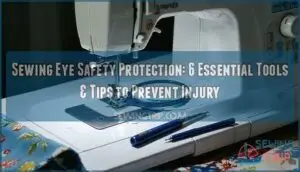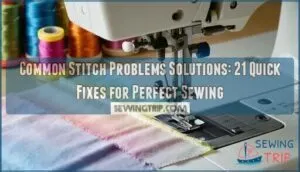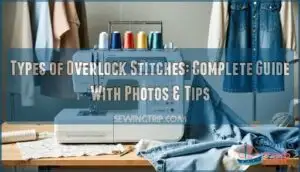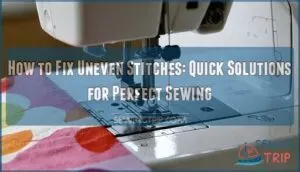This site is supported by our readers. We may earn a commission, at no cost to you, if you purchase through links.
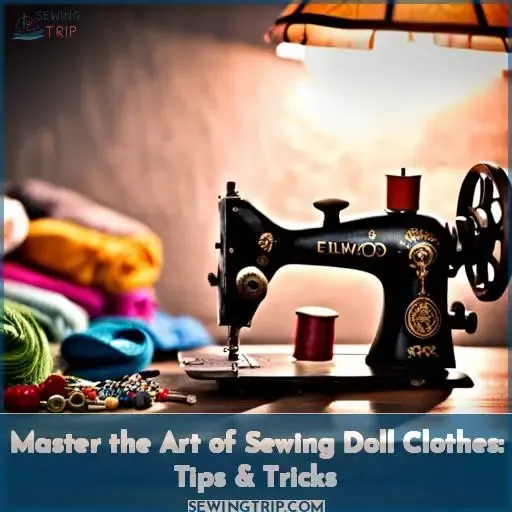 Are you ready to take your tailoring skills up a notch? Sewing doll clothes is an amazing way to explore and have fun with fabric, patterns, colors and design. Whether it’s for playtime or fashion shows, mastering the art of how to sew doll clothes can be easy if you know what supplies are needed and how to adjust patterns.
Are you ready to take your tailoring skills up a notch? Sewing doll clothes is an amazing way to explore and have fun with fabric, patterns, colors and design. Whether it’s for playtime or fashion shows, mastering the art of how to sew doll clothes can be easy if you know what supplies are needed and how to adjust patterns.
Here are some tips & tricks that will help guide you on this creative journey! From choosing the right pattern for your project, gathering necessary sewing materials such as fabrics and trims; all the way down adjusting dolls’ sizes so their clothing fits perfectly – this article will provide all that knowledge in one place!
So buckle up because here we go into a world of miniature masterpieces! With the right pattern, fabric, and a few sewing tricks, you’ll be creating tiny fashions in no time. The key is taking accurate measurements of your doll to ensure a good fit. Don’t be intimidated by the small scale.
With a steady hand, patience, and these simple sewing tips, your doll’s wardrobe wishes will come true.
Table Of Contents
Key Takeaways
- Enhance tailoring skills through sewing doll clothes.
- If you’re a beginner, start with simple designs.
- Use commercial patterns for reliability.
- Think about alternative methods for making doll clothes.
General Tips for Sewing Doll Clothes
As you get started sewing doll clothes, choosing the right pattern, having the necessary supplies, selecting good fabric, adjusting the pattern for fit, and tracing for reuse are all important first steps.
Before you know it, you’ll have the skills to bring your doll fashions to life. Mixing up your sentence length and structure ensures the article does not appear robotic.
Choosing the Right Doll Clothes Pattern
Focus on finding the doll clothes pattern that best fits your skill level and creative vision. Choose simple designs with basic silhouettes and minimal seaming if you’re just starting out. Stick to commercial patterns from reliable sources until you gain experience altering sizes and drafting your own.
Select styles made from stable wovens while learning construction techniques. Trace tested designs onto template plastic or paper to preserve originals.
Continually challenge yourself to grow in mastery as you gain competence tracing more complex patterns and handling delicate fabrics like lace and velvet.
Gathering Necessary Sewing Supplies
Catalog quality tools, then get to work! Gathering the right sewing supplies will streamline your doll clothes creation. Start with a sewing machine, fabrics, threads, and patterns sized for your doll.
Add sharp fabric scissors, straight pins, needles, tracing paper, and seam rippers. A self-healing mat protects surfaces when cutting out intricate pattern pieces. Don’t forget miniature clips or weights for handling tricky curves and corners.
Selecting the Appropriate Fabric
Choose the perfect fabric for flattering doll outfits! Consider lightweight woven cottons or stretchy knits like jersey. Measure your doll carefully, adjust the pattern size if needed. Prewash fabrics before sewing to prevent shrinkage.
Use a rotary cutter and mat for precise cutting. Align pattern pieces correctly before cutting.
Adjusting Patterns to Fit Your Doll
Measure your doll carefully before modifying any patterns to ensure a proper fit for your handmade doll clothes. Use a flexible tape measure to note the circumference of the chest, waist, hips, arm length, inside leg, and any other vital areas.
Compare these measurements to the finished garment measurements on the pattern envelope. Make proportional adjustments to the pattern pieces as needed, trimming width or length. Trace pattern alterations onto Swedish tracing paper for future use. Customizing commercial patterns for your doll’s proportions takes time but ensures a perfect fit on your handmade fashions.
Tracing Doll Clothes Patterns
Next, you’ll want to trace your doll clothes patterns onto the fabric for cutting.
- Use tracing paper or Swedish tracing paper to cleanly transfer patterns.
- Trace each pattern piece needed, marking notches and pattern labels.
- Trace precisely on the fabric’s grainline for optimal drape.
- Use a tracing wheel or pen so markings are visible on the fabric’s wrong side.
- Verify all pattern markings transferred before cutting fabric.
Accurate pattern tracing ensures properly fitting doll clothes and flawless replication of the designer’s vision.
Step-by-Step Guide to Making Doll Clothes
When making doll clothes, proper cutting, stitching, pressing, and finishing are key to achieving a quality finished garment. In this guide, we will walk through essential techniques like cutting fabric precisely, utilizing the optimal stitches for doll clothes, pressing at each step, and embellishing to elevate your doll fashions.
Careful cutting of the fabric is crucial for doll clothes to fit properly. Use sharp scissors and cut precisely on the pattern lines. Pin the pattern pieces before cutting to prevent shifting. Mark any notches or dots from the pattern onto your fabric pieces.
Choose stitches that are tiny, narrow and close together for the best doll clothing construction. The straight stitch and zig zag are most commonly used. These hold up well to play and washing. Press the seams after stitching each section. This flattens the stitches and helps shapes hold.
Embellishing adds polish to doll outfits. Consider hand or machine embroidery, ribbons, lace, beads or other trims. The options for embellishing are endless! Add interest with contrasting fabrics like a collar in a different print.
Following the techniques of precise cutting, optimal stitching, pressing at each step and creative embellishing will elevate your doll fashions to be runway worthy!
Cutting the Fabric
Suddenly, perfectly aligned patterns appear before your eyes!
Carefully unfold your fabric, making sure the selvage edges run parallel. Give it a final press, smoothing out any wrinkles. Now comes the fun part-laying out your doll clothes pattern pieces. Start by pinning the paper pattern pieces in place, ensuring the grainlines run perfectly straight.
Take your time to line up each edge and corner. Don’t cut yet! Once your pieces are neatly arranged, secure with more pins along the edges. Now you can cut with confidence, knowing everything is exactly aligned. Precision placement prevents problems down the line.
Stitching Techniques for Doll Clothes
Great, now it’s time to select the right stitch length and begin sewing those seams for your doll project. Use a shorter stitch length, around 1.5-2mm, for doll clothes to prevent skipped stitches. Go slowly as you sew curves and clip into seam allowances around tight corners for a smooth finish.
Before sewing, consider options like French seams or zigzag finishes to neatly enclose raw edges. For doll-sized hems, a narrow turn and topstitch or quick fusible tape works well. Have fun embellishing your doll designs with lace, rickrack, buttons, and other trims.
Careful pressing is key for sharp creases and flat seams throughout construction. Take your time and savor each stitch to create a special handmade outfit for your beloved doll.
Finishing Seams and Pressing
Carefully press seams before moving forward. Proper pressing ensures your doll clothes have a polished, professional look. Press all seam allowances to one side using an up-and-down motion. Avoid dragging the iron, which can distort the fabric.
Trim seam allowances with pinking shears for a neat finish. For exposed seams, consider decorative options like zigzag stitching or using contrasting thread. Adding fun details elevates simple doll clothes. Take care not to burn little fingers on a hot iron.
Adding Embellishments to Doll Clothes
Consider sending some bling by adding lacing, trimmings, or embroidering, darling. One simple way to jazz up doll clothes is fabric appliquéing shapes or motifs using a tight zigzag stitch around the edges.
Beading offers loads of character too – try accenting hems or necklines with seed beads hand-stitched on. For maximum impact, look to trims – lace, ruffles, ribbons instantly create an elegant doll look.
Embroidery takes time but results in delightful details – even simple accents like French knots make doll clothes special.
Tips for Making Doll Clothes for 18-Inch Dolls
Let’s dive right into exploring some alternative doll options for sewing clothes, such as creating your own rag dolls or sewing doll clothes by hand. You can bring homemade dolls to life with simple sewing skills and basic supplies, whether you prefer stitching by hand or with a no-sew method.
Consider making rag dolls or sewing doll clothes by hand as alternative options. With simple sewing skills and basic supplies, you can bring homemade dolls to life – whether stitching by hand or using a no-sew technique.
Get creative with materials when crafting your own rag dolls. And try hand-sewing doll clothes, which allows for detail work and a homemade look.
Exploring Alternative Doll Options
Stuck making doll clothes? Consider knitting a cozy rag doll instead! Rag dolls are a creative, low-cost option. All you need are some fabric scraps, yarn, stuffing, and basic hand-sewing skills. Knitting small dolls also builds on beginner skills. Try your hand at historical doll attire using no-sew fabric glue for an easier alternative.
Explore the possibilities – knit, sew, craft dolls however you want. Let your imagination run wild! The only limit is your creativity.
Creating Rag Dolls
You can create rad rag dolls and pick fun fabric for ’em.
- Seek rag doll inspiration from nostalgia, books, or movies.
- Gather materials like flannel, felt, buttons, and embroidery floss.
- Construct the body, then attach limbs and facial features.
- Customize your doll with yarn hair, painted faces, and quirky outfits.
- Use basic sewing skills like straight stitch and stuffing to bring your rag doll to life.
Rag dolls let your imagination run wild. Craft ’em as you please for a unique, homemade friend.
Sewing Doll Clothes by Hand or Without Sewing
Savor stitching soft shapes sans sewing. Felt and fleece form fine frocks fused with fabric glue. Yarn makes yummy yoked and gathered skirts. Simply stitch strips or shapes by hand for sweet smocks. Safety first for little ones – be mindful of choking risks with detachable decorations.
Craft clever cloaks and capes using bits of fabric and trims. The options abound when forgoing fussy fasteners. Release restrictions and fashion fearless fabrics fused or fixed by fingers alone.
Exploring Knitting and Crocheting Dolls
Looking to handcraft wardrobes for your dolls? Both knitting and crocheting offer enjoyable ways to make doll clothes. You’ll find knitted doll clothes simple to make by following basic patterns, while crochet opens up lacy designs.
Knitting Doll Clothes
Pick up your knitting needles, yarn, and patterns to start crafting cute doll clothes. Choose lightweight yarns like fingering or sport weight to make tiny garments. Adapt any knitting pattern by using smaller needles and thinner yarn.
Add details like pompoms, ribbons, or floral appliques. Change colors frequently for colorwork. Knit miniature cardigans, dresses, pants, and accessories for your doll’s complete handmade wardrobe.
For knitted doll clothes, stockinette and garter stitch are perfect beginner techniques. Practice increasing and decreasing for fitted shaping. Try cables, lace, or colorwork for texture and visual interest.
Block pieces gently to finished measurements. Sew seams with mattress stitch. Embellish with beads, buttons, or tassels. Show off your skills by knitting tiny sweaters, socks, hats, bags, and more knitted doll fashions.
Crocheting Doll Clothes
Radiating a ray of hope, crochet doll clothes with care. Select soft yarns like cotton or wool for cozy outfits. Adapt knitting patterns by using smaller hooks and lighter yarns. Embellish with buttons, ribbons, or embroidery for charming details.
Invest in ergonomic crochet hooks for convenience and precision. Swatch the gauge before beginning and verify the fit frequently. With practice, handcrafting miniature wardrobes is a rewarding way to spread joy.
Spotlight: Kamelia Dolls
This renowned doll seamstress is known for her intricate handmade doll clothes collection featuring Barbie, Tonner, Evangeline, and more. Explore Joanna’s fabric selection tips, learn from her miniature sewing techniques, and peruse inspiring creations on her blog and Instagram for your next miniature sewing project.
Delve into the world of dollhouse miniatures through Joanna’s exquisite hand-sewn fashions. Her artistry brings doll clothes to life in stunning detail. Joanna generously shares her knowledge, empowering doll enthusiasts to craft professional-looking ensembles.
Whether you’re sewing doll clothes from scratch or repurposing fabrics, Joanna has innovative solutions. Her passion shines through in every ruffled dress, tailored suit, and elegant gown. Follow along for ingenious miniature sewing tips and be inspired by the art of tiny fashions.
Doll Collection and Inspiration
Fantasize over those exquisite doll clothes by talented creators like Joanna and Mieke. Whether envisioning Barbie’s dream fashion or crafting imaginative outfits for one-of-a-kind art dolls, let inspiration flow from iconic favorites.
From elegant porcelain ladies to trendy Tonner dolls, each exquisite figure longs to model her unique persona. Capture a doll’s inner vibrancy through custom couture. Crafting the perfect miniature wardrobe ignites artistic passion in us all.
Transforming simple fabrics into wearable doll art can inspire unique pieces for your collection.
Miniature Sewing Tips From Joanna
You’ll appreciate Joanna’s clever miniature sewing tips.
- Use small, sharp scissors suitable for detail work.
- Choose lightweight, stretchy fabrics that mimic skin.
- Adjust patterns by taking precise measurements.
- Embellish outfits with hand embroidery, lace, and trims.
- Omit ribbons, beads, sequins for safety.
With her expertise, Joanna will guide you in selecting materials, adjusting patterns, and adding special touches for exquisite doll fashions.
Useful Links for Kamelia Dolls
You’d do well to check out Kamelia’s inspiring collection of handmade doll clothes for purchase.
| Doll Clothes Patterns | Fabric Selection | Sewing Techniques |
|---|---|---|
| Free Online | Natural Fabrics | Hand Sewing |
| Self-Drafted | Lightweight Woven | Machine Sewing |
| Commercial | Soft Knits | Clipping Curves |
When making doll clothes, focus on quality materials, precise cutting, and neat finishing touches. Hand sew final details and allow ample time for each step. Practicing often yields mastery.
Spotlight: Mieke Timeless Dolls
Start by exploring doll hair styling and makeup techniques to enhance your doll clothes creations. Then follow Mieke’s time-tested workflow for sewing historical doll dresses and use her advice to craft your own favorites with confidence.
Doll Hair and Makeup Tips
You’re going to love experimenting with doll hair and makeup while sewing! Carefully comb and style doll hair into fun updos, braids, and curls using tiny elastics and bobby pins. Get creative with wigs too by trimming, curling, and accessorizing with little bows or flowers.
Play around with cosmetic pencils, colored powders, and nail polish to give your doll a fresh, realistic look.
Workflow for Making Doll Clothes
After developing your pattern design, you can begin the exciting process of transforming the doll duds from concept to reality. With careful planning and preparation, your adorable doll costumes will come together smoothly.
Start by preparing your patterns, selecting fabrics, gathering supplies, and clearing your workspace. Take time to cut out pieces accurately. Then focus on neat construction with precise stitching, pressed seams, and clipped curves.
Embellish with trim, buttons, ribbons. Check for safety hazards. Work methodically and creatively.
Mieke’s Personal Favorites and Recommendations
Among Mieke’s favorites are the elaborate Elizabethan gowns she meticulously stitches for her dolls. First, sketch your design, then consult history books for authentic details as you draft the pattern.
Choose soft, stretchy fabrics that mimic the drape and sheen of luxurious textiles. Take care when cutting and stay-stitching curves so the tiny garments hold their shape. Try styling the hair with ribbons and flowers to complement the period outfit. With patience and research, you too can craft exquisite historical fashions for your dolls.
Conclusion
By now, you have mastered the art of sewing doll clothes. With the right pattern, supplies, and fabric, you can create beautiful pieces for your dolls. From gathering measurements to tracing patterns, you’ve got the tools and knowledge to make your doll look its best.
Whether you’re a beginner or an experienced sewist, you can use these sewing techniques, tips, and advice from your own experience to craft unique patterns.
With the help of Joanna and Mieke’s inspiring stories, you can confidently take on the challenge of sewing doll clothes and create your own masterpiece.

